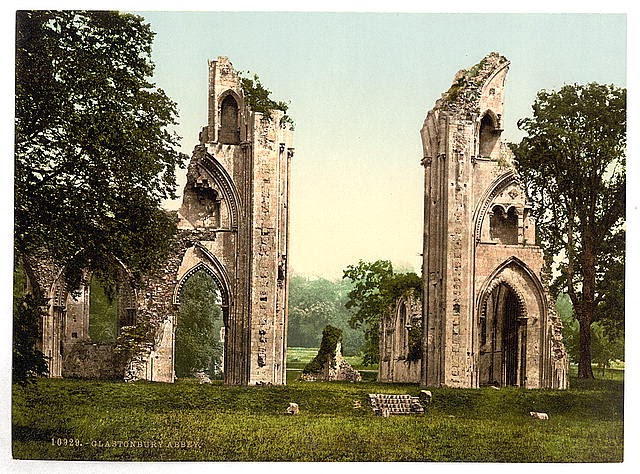I've only watched a single episode, so perhaps its explained in it somewhere, but I've wondered how many people who watch Downton Abbey wonder why the estate is bears the name abbey? Maybe that's explained in the series. If it is, I'd appreciate somebody coming in and letting us know. The name, given that it is a drama, would be a bit of a mystery otherwise, however. Abbeys, after all, are religious institutions, being monasteries headed by an abbot.
Well, that's because King Henry VIII ruined centuries of English religious culture in his increasingly nasty efforts to separate the church in England from Rome, brought about by the fact that Rome wouldn't recognize his attempt at an annulment.
Furness Abbey. Founded in 1123, disestablished in 1537 by King Henry VIII.
England was a religious nation, indeed one recent historian has claimed that England's identity was that it was so strongly Catholic prior to Henry VIII. In his dispute with Rome, he listened to those who would have, and did, destroy much of that culture, including destroying the centuries old monastic culture of England which was so strong. The monasteries and convents were closed. After that, they fell into picturesque ruins, and often into private hands, with their place names retained by later owners.
Bolton Abbey, now part of a 33,000 acre estate.
Many of these ruins remain today, making for spectacular examples of ruined church architecture. They are sometimes massive, and very often very well built, explaining how they've lasted the centuries after falling into disuse.
Tintern Abbey, Wales. This abbey passed from the Church into private hands in 1540 and the lead was immediately stripped from the roof.
They are, however, also frightening examples of how ruin, turmoil and decay can come in almost overnight. Prior to Henry VIII there was no thought in England of turning monks and nuns out of their monasteries. And the act came, at the end of the day, because the King's head turned from his bride Catherine of Aragon. Catherin was the "true Queen" and held that position without question until 1533. Few doubt today that her position was legitimate, and few would dispute that Henry's desire to be rid of her, in the hopes that he could bear children, lead to his break with Rome and in turn, the destruction of a monastic history in England that had gone back centuries. Nobody would have seen that coming.
Ruins of Cistercian Abbey in Wales. It had been operating 400 years when King Henry VIII closed the monasteries. It's now protected by the Welsh government.
Valle Crucis Abbey, Wales. It was closed by King Henry VII in 1537 and leased to a private owner. It's now protected by the Welsh government
Lincluden Abbey, Scotland. Still a ruin today.
Sweetheart Abbey, Scotland.
Iona Abbey, Scotland. This site has been partially rebuilt in recent years by the Church of Scotland.
Glastonbury Abbey, England.
Nor would anyone have seen it coming that those desiring land would take advantage of this situation in this fashion, when only a few years prior the same men would have proclaimed loyalty to the same institutions.
Valle Crucis Abbey, Wales. It was closed by King Henry VII in 1537 and leased to a private owner. It's now protected by the Welsh government
That some would even stoop to stripping lead from roofs is amazing, and not admirable. So, while these ruins are picturesque, they also serve as monuments to the worst instincts of man, and that man will turn from even declared loyalties almost over night under some circumstances.
Lincluden Abbey, Scotland. Still a ruin today.
And it was, moreover, a disaster for the English. The monasteries held land that was used to feed the monks, and the poor. The transfer of the monasteries suddenly put the poor into jeopardy and the English crown was faced for the first time with dealing with a landless poor population. It also resulted in the destruction of what were effectively institutions of learning, as the monasteries had also taken on that role for centuries.
Sweetheart Abbey, Scotland.
All of which goes to make for a cautionary tale. And not a pleasant one. The results of Henry VIII's actions were destructive, cruel and permanent.
Iona Abbey, Scotland. This site has been partially rebuilt in recent years by the Church of Scotland.
They should give us pause for any such proposed radical change, let alone the changes proposed by wreckers of one kind or another today.
Glastonbury Abbey, England.
And in remembering that, it should be remembered that movements that start off claiming adherence to one idea or another can surrender to human greed and self interest amazingly fast. Henry claimed to be advancing a point of theology, although the weakness of it was fairly clear. In the end, those who supported him turned to self interest pretty quickly in some instances.
Netley Abbey, founded in 1239, disestablished in 1536.
And such things can result in misery for the many quickly too. Monastic lands that supported poor farmers and fed the poor went to landed interest who didn't do that, and their descendants held on to the land for centuries. Movements that claim to be for the good of all, can turn out to be for the good of few, almost instantly.










1 comment:
This doesn't answer your question about Downton Abbey's name having Abbey in it. However, as a side note, the series is filmed at Highclere Castle, which is still a private dwelling of the Count Carnarvon. One of the previous Count's was the man that discovered King Tut's tomb. However, Highclere Castle is not a "castle" in the typical American understanding of the word, i.e., a medieval castle. It is more of a manor house/estate.
Post a Comment